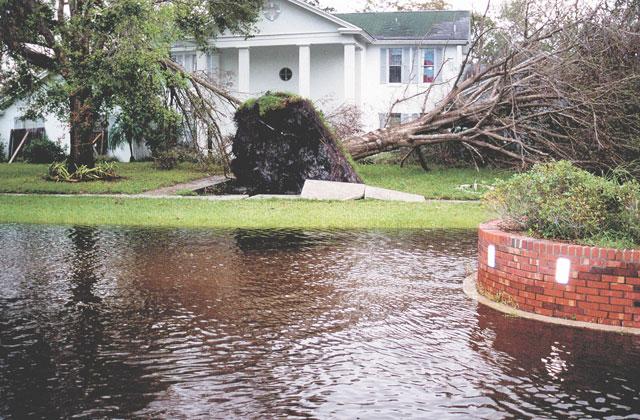By Ken Jackson
News-Gazette Editor
As far as experiences with storm systems go, Tropical Storm Elsa won’t rank up there with the hurricanes whose names are burned into our brains.
Some rain and wind, and watching for flooding, is nothing Osceola County residents can’t handle.
Per the Osceola County Emergency Operations Center, the county should get the worst of its weather beginning Tuesday (today) through early Wednesday afternoon. Expect rain showers in squalls, with potential gusts of 40-60 mph embedded in those squalls. Sustained winds should stay in the 15-20 mph range.
"Really, it's not much more than a typical Florida summer thunderstorm, outside of the squalls," said Osceola EOC Director Bill Litton. "We will have to watch for a moderate threat of flooding, as well as tornadoes, but if they do form they'll likely be short-lived and may not even touch the ground. We recommend residents find and use a weather radio, in order to get updates in warnings, especially during the overnight."
Elsa, churning up through the Gulf of Mexico just west of the Florida peninsula, isn't the best scenario for us. In fact, the NHC spent much of the weekend reminding us the storm would be “very asymmetrical tropical cyclone (Tuesday and Wednesday) with most of the heavy rain and strongest winds displaced along and to the east of the forecast track."
The storm will serve as a good practice run to polish up storm preparations, take stock of supplies and top off those things running a little low. It's also a good time to sign up for Alert Osceola, a system enabling the county to provide residents with critical information quickly in a variety of situations, such as severe weather, unexpected road closures, missing persons and evacuations of buildings or neighborhoods, in English and en Espanol.
Register here: https://www.osceola.org/agencies-departments/emergency-management/alert-osceola/
The good about going through 2017’s Hurricane Irma – can you believe it’ll be four years ago later this season? – or the storm season of 2004, with their widespread power outages, massive tree and structure damage, is that we here in the interior of the state, without having to deal with coastal storm surge, got valuable storm experience.
The County’s Emergency Operations Center, which takes the lead on bringing all local governments and agencies together to spearhead the preparation, and the eventual response and recovery from such a storm, plans to remain at Level 3 activation, or “Monitoring” – its general, “everyday” personnel staffing level, Litton said. A Level 2 “Elevated Activation” would see the EOC staffed by emergency management personnel, necessary support staff and outside agencies as required to meet the operational needs of the situation.
Why share this? Because, based on your experience – which means nothing if you don’t remember it – residents should have been following storm updates from the News-Gazette, National Hurricane Center or other news sources, prepared to take their own Level 2 precautions in the event of a sudden shift in storm track or intensity.
Faster than you can say, “That doesn’t happen,” be reminded that’s exactly what Hurricane Charley did in 2004 to kickstart that incredible season; Charley happened all over Osceola County and inland Central Florida, bringing wind damage and power outages. Hurricanes Frances and Jeanne followed weeks later bringing heavy rain and flooding.
So Elsa should provide a wet and windy reminder to get storm ready for the hurricane season – but then again, we’re a month into it, so what took you so long? – and here are some of your consideration, from safety and emergency planning experts:
Check if you are in a flood-prone area. The catchphrase for hurricanes is, “Run from the water, hide from the wind.” Take note if you’ll have to evacuate. Plan your escape route. Share it with friends and family.
Get your property ready now. Your home is your shelter if you’re riding outa storm there. Inspect the roof for aging shingles. Prune dead branches and those near the house away from trees, and clear growth from the center so wind can pass through easier, reducing risk of uprooting. Water will need somewhere to go, too, so clear gutters and downspouts. Do this work now rather than in the heat of August or September — or in the stress of an imminent storm.
Take stock of supplies. Flashlights, batteries, canned food and water (authorities now suggest five days per person) and grill fuel (propane or charcoal) are storm season necessities. Accumulate through the year, then top off for need if a storm is coming, keeping in mind others will be at stores depleting stock.
Plan for pets. Osceola County will have pet-friendly storm shelters. But they can fill up as coastal residents may evacuate inland. Try to find a friend or relative you can take a pet to, leaving shelters as a last resort.
Fill prescriptions. Look into securing 90-day supplies of essential medications, especially during storm season.
If you get a generator, learn how to use it. It must be operated outside in a well-ventilated area to avoid carbon monoxide poisoning.
Be ready to act. When a storm is bearing down, trips to buy plywood for windows (now is a good time to measure them), fill gas tanks and cans and wallets with cash will need to be made — but everyone else will be doing the same, straining supplies.
Like Litton said, get a weather radio. Aside from providing breaking weather information, they can alert your family during the night in case of an emergency, like a pop-up tornado warning.
Think about insurance issues. Consider a weather and fire-proof safe for important documents. If possible, scan and email them to relatives in another area. Walk your home with a camera and make a video of its contents; keep that in the safe or maintain it digitally.
The remaining storm names for 2021 are: Fred, Grace, Henri, Ida, Julian, Kate, Larry, Mindy, Nicholas, Odette, Peter, Rose, Sam, Teresa and Wanda. Should those get used up, the NHC will not revert to the Greek alphabet like last year; there’s a backup list of names that will begin.



